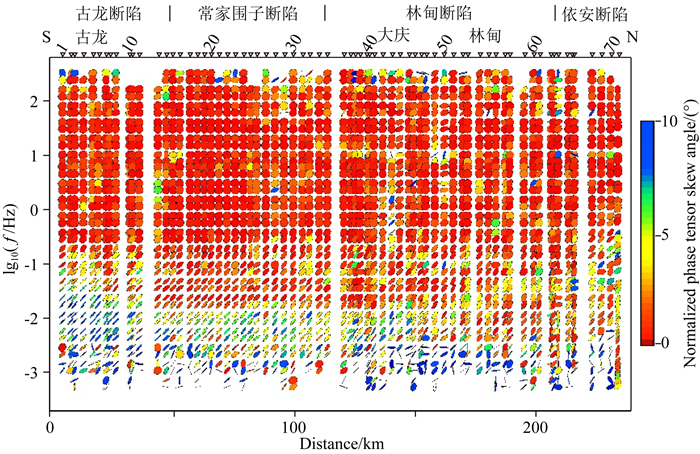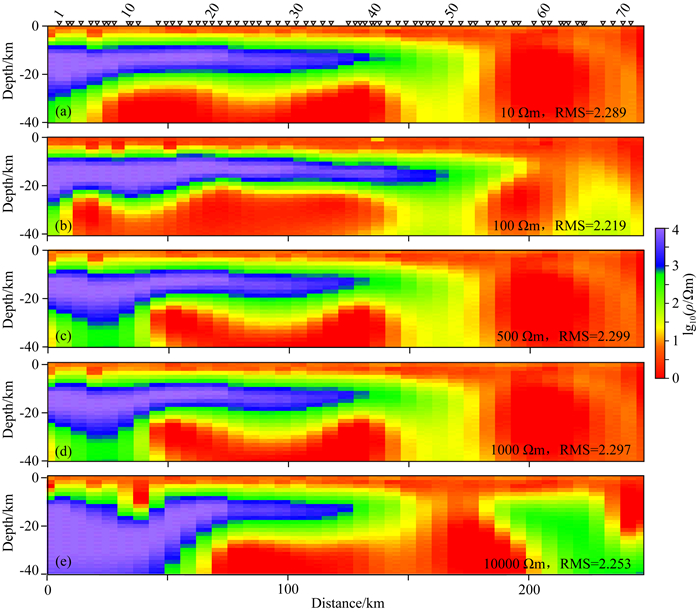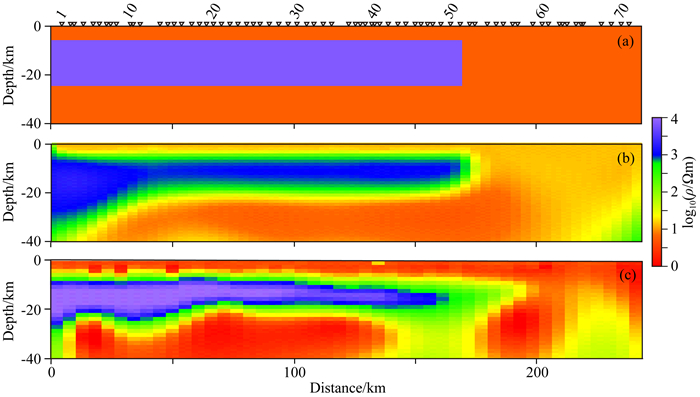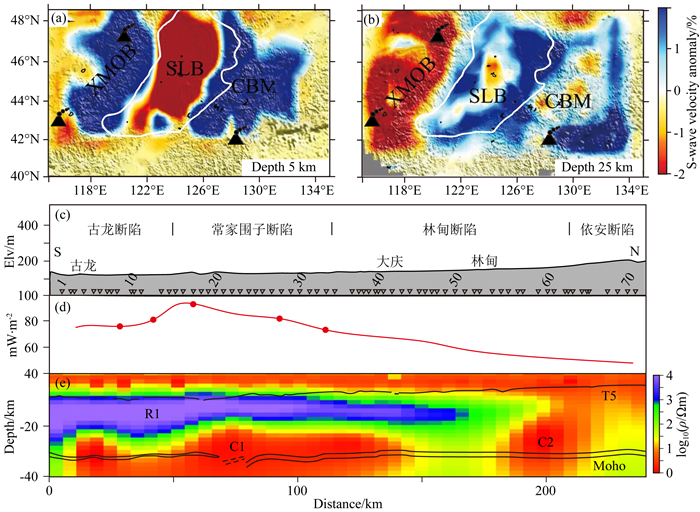|
|
Cai J T, Chen X B. 2010. Refined techniques for data processing and two-dimensional inversion in magnetotelluric Ⅱ: Which data polarization mode should be used in 2D inversion. Chinese Journal of Geophysics (in Chinese), 53(11): 2703-2714. DOI:10.3969/j.issn.0001-5733.2010.11.018 |
Cai J T, Chen X B, Zhao G Z. 2010. Refined techniques for data processing and two-dimensional inversion in magnetotelluric Ⅰ: Tensor decomposition and dimensionality analysis. Chinese Journal of Geophysics (in Chinese), 53(10): 2516-2526. DOI:10.3969/j.issn.0001-5733.2010.10.025 |
|
Chen C X, Yan J Y, Zhou W Y, et al. 2020. Status and prospects of geophysical method used in geothermal exploration. Progress in Geophysics (in Chinese), 35(4): 1223-1231. DOI:10.6038/pg2020DD0229 |
Darnet M, Wawrzyniak P, Tarits P, et al. 2020. Mapping the geometry of volcanic systems with magnetotelluric soundings: Results from a land and marine magnetotelluric survey performed during the 2018-2019 Mayotte seismovolcanic crisis. Journal of Volcanology and Geothermal Research, 406: 107046. DOI:10.1016/j.jvolgeores.2020.107046 |
Delhaye R, Rath V, Jones A G, et al. 2019. Quantitative geothermal interpretation of electrical resistivity models of the Rathlin Basin, Northern Ireland. Geothermics, 77: 175-187. DOI:10.1016/j.geothermics.2018.09.012 |
Didana Y L, Thiel S, Heinson G. 2015. Three dimensional conductivity model of the tendaho high enthalpy geothermal field, NE Ethiopia. Journal of Volcanology and Geothermal Research, 290: 53-62. DOI:10.1016/j.jvolgeores.2014.11.013 |
|
Erdoğan E, Candansayar M E. 2017. The conductivity structure of the Gediz Graben geothermal area extracted from 2D and 3D magnetotelluric inversion: synthetic and field data applications. Geothermics, 65: 170-179. DOI:10.1016/j.geothermics.2016.09.007 |
Esquivel T A, Flores C, Ortega V R, et al. 2020. Magnetotelluric exploration of the Wagner Basin, Gulf of California, Mexico: Evidence for an axial magma chamber and hydrothermal circulation. Journal of South American Earth Sciences, 99: 102501. DOI:10.1016/j.jsames.2020.102501 |
Fu W, Hou H S, Gao R, et al. 2019. Fine structure of the lithosphere beneath the Well SK-2 and its adjacent: Revealed by deep seismic reflection profile. Chinese Journal of Geophysics (in Chinese), 62(4): 1349-1361. DOI:10.6038/cjg2019M0370 |
Fu X F, Sha W, Wang L, et al. 2010. Distribution law of mantle-origin CO2 gas reservoirs and its controlling factors in Songliao Basin. Journal of Jilin University (Earth Science Edition) (in Chinese), 40(2): 253-263. |
Gao J, Zhang H J, Zhang S Q, et al. 2018. Three-dimensional magnetotelluric imaging of the geothermal system beneath the Gonghe Basin, Northeast Tibetan Plateau. Geothermics, 76: 15-25. DOI:10.1016/j.geothermics.2018.06.009 |
Gao J, Zhang H J, Zhang H P, et al. 2020. Three-dimensional magnetotelluric imaging of the SE Gonghe Basin: Implication for the orogenic uplift in the northeastern margin of the Tibetan plateau. Tectonophysics, 789: 228525. DOI:10.1016/j.tecto.2020.228525 |
Ge R F, Wang Q L, Wang S L, et al. 2010. Tectonic evolution of Songliao Basin and the prominent tectonic regime transition in eastern China. Geological Review (in Chinese), 56(2): 180-195. |
Guo Z, Cao Y L, Wang X G, et al. 2014. Crust and upper mantle structures beneath Northeast China from receiver function studies. Earthquake Science, 27(3): 265-275. DOI:10.1007/s11589-014-0076-x |
Guo Z, Wang K, Yang Y J, et al. 2018. The origin and mantle dynamics of quaternary intraplate volcanism in Northeast China from joint inversion of surface wave and body wave. Journal of Geophysical Research: Solid Earth, 123(3): 2410-2425. DOI:10.1002/2017JB014948 |
Hacıoğlu Ö, Başokur A T, Diner Ç, et al. 2020. The effect of active extensional tectonics on the structural controls and heat transport mechanism in the Menderes Massif geothermal province: Inferred from three-dimensional electrical resistivity structure of the Kurşunlu geothermal field (Gediz Graben, western Anatolia). Geothermics, 85: 101708. DOI:10.1016/j.geothermics.2019.07.006 |
Han J T, Guo Z Y, Liu W Y, et al. 2018. Deep dynamic process of lithosphere thinning in Songliao Basin. Chinese Journal of Geophysics (in Chinese), 61(6): 2265-2279. DOI:10.6038/cjg2018L0155 |
Hersir G P, Árnason K, Vilhjálmsson A M, et al. 2020. Krysuvík high temperature geothermal area in SW Iceland: Geological setting and 3D inversion of magnetotelluric (MT) resistivity data. Journal of Volcanology and Geothermal Research, 391: 106500. DOI:10.1016/j.jvolgeores.2018.11.021 |
Hu S B, He L J, Wang J Y. 2001. Compilation of heat flow data in the china continental area (3rd edition). Chinese Journal of Geophysics (in Chinese), 44(5): 611-626. |
Hu W S, Lü B Q, Zhang W J, et al. 2005. An approach to tectonic evolution and dynamics of the Songliao Basin. Chinese Journal of Geology (in Chinese), 40(1): 16-31. |
Hu X, Lü J C. 2016. Distribution characteristics of favorable thermal storage areas in the northern Songliao Basin. West-China Exploration Engineering (in Chinese), 28(3): 33-37. |
Jiang G Z, Gao P, Rao S, et al. 2016. Compilation of heat flow data in the continental area of China (4 th edition). Chinese Journal of Geophysics (in Chinese), 59(8): 2892-2910. DOI:10.6038/cjg20160815 |
Kana J D, Djongyang N, Raïdandi D, et al. 2015. A review of geophysical methods for geothermal exploration. Renewable and Sustainable Energy Reviews, 44: 87-95. DOI:10.1016/j.rser.2014.12.026 |
Kang D, Shen W S, Ning J Y, et al. 2016. Seismic evidence for lithospheric modification associated with intracontinental volcanism in Northeastern China. Geophysical Journal International, 204(1): 215-235. DOI:10.1093/gji/ggv441 |
Karlsdóttir R, Vilhjálmsson A M, Guənason E Á. 2020. Three dimensional inversion of magnetotelluric (MT) resistivity data from Reykjanes high temperature field in SW Iceland. Journal of Volcanology and Geothermal Research, 391: 106498. DOI:10.1016/j.jvolgeores.2018.11.019 |
Li C, Liu S F. 2015. Cretaceous anomalous subsidence and its response to dynamic topography in the Songliao Basin, Northeast China. Journal of Asian Earth Sciences, 109: 86-99. DOI:10.1016/j.jseaes.2015.04.045 |
Li S H, Unsworth M J, Booker J R, et al. 2003. Partial melt or aqueous fluid in the mid-crust of Southern Tibet? Constraints from INDEPTH magnetotelluric data. Geophysical Journal International, 153(2): 289-304. DOI:10.1046/j.1365-246X.2003.01850.x |
Li X, Ma X B, Chen Y, et al. 2020. A plume-modified lithospheric barrier to the southeastward flow of partially molten Tibetan crust inferred from magnetotelluric data. Earth and Planetary Science Letters, 548: 116493. DOI:10.1016/j.epsl.2020.116493 |
Li Y. 2017. Preliminary study on EGS geothermal resources evaluation and exploration in Song-Liao Basin[Master's thesis](in Chinese). Changchun: Jilin University.
|
Liang H D, Jin S, Wei W B, et al. 2017. Deep electrical structure of the eastern margin of the Erguna massif and the western margin of the Xing'an massif. Chinese Journal of Geophysics (in Chinese), 60(2): 564-574. DOI:10.6038/cjg20170211 |
Lichoro C M, Árnason K, Cumming W. 2019. Joint interpretation of gravity and resistivity data from the Northern Kenya volcanic rift zone: Structural and geothermal significance. Geothermics, 77: 139-150. DOI:10.1016/j.geothermics.2018.09.006 |
Liu C P, Zhong X, Zhu H L. 2016. Research on the formation mechanism for the medium-low geothermal field in the north of Songliao basin. Geological Survey and Research (in Chinese), 39(4): 316-320. |
Liu Y, Hu D G, Xu Y X, et al. 2019. 3D magnetotelluric imaging of the middle-upper crustal conduit system beneath the Lei-Hu-Ling volcanic area of northern Hainan Island, China. Journal of Volcanology and Geothermal Research, 371: 220-228. DOI:10.1016/j.jvolgeores.2019.01.013 |
|
Olasolo P, Juárez M C, Morales M P, et al. 2016. Enhanced geothermal systems (EGS): a review. Renewable and Sustainable Energy Reviews, 56: 133-144. DOI:10.1016/j.rser.2015.11.031 |
Ozen T, Bulbul A, Tarcan G. 2010. Reservoir and hydrogeochemical characterizations of the Salihli geothermal fields in Turkey. //World Geothermal Congress. Bali, Endonesia, 1-10.
|
Pei M B. 2008. Study on sequence stratigraphy of deep order of Paleo-central uplift belt[Master's thesis](in Chinese). Daqing: Daqing Petroleum Institute.
|
Rodi W, Mackie R L. 2001. Nonlinear conjugate gradients algorithm for 2-D magnetotelluric inversion. Geophysics, 66(1): 174-187. DOI:10.1190/1.1444893 |
Song Y, Ren J Y, Liu K Y, et al. 2018. Post-rift anomalous thermal flux in the Songliao Basin, NE China, as revealed from fission track thermochronology and tectonic analysis. Palaeogeography, Palaeoclimatology, Palaeoecology, 508: 148-165. DOI:10.1016/j.palaeo.2018.07.030 |
Sun C C. 2019. The research of the basement tectonic characteristics of Songliao basin based on geophysical methods[Master's thesis](in Chinese). Changchun: Jilin University.
|
Tian Y, Ma J C, Liu C, et al. 2019. Effects of subduction of the western Pacific plate on tectonic evolution of Northeast China and geodynamic implications. Chinese Journal of Geophysics (in Chinese), 62(3): 1071-1082. DOI:10.6038/cjg2019M0061 |
Tzanis A, Efstathiou A, Chailas S, et al. 2020. The Methana Volcano-Geothermal Resource, Greece, and its relationship to regional tectonics. Journal of Volcanology and Geothermal Research, 404: 107035. DOI:10.1016/j.jvolgeores.2020.107035 |
Volpi G, Manzella A, Fiordelisi A. 2003. Investigation of geothermal structures by magnetotellurics (MT): an example from the Mt. Amiata area, Italy. Geothermics, 32(2): 131-145. DOI:10.1016/S0375-6505(03)00016-6 |
Wang C W, Sun Y W, Li N, et al. 2009. Tectonic implications of Late Paleozoic stratigraphic distribution in Northeast China and adjacent region. Science in China Series D: Earth Sciences, 52(5): 619-626. DOI:10.1007/s11430-009-0062-7 |
Wang F, Xu W L, Gao F H, et al. 2014. Precambrian terrane within the Songnen-Zhangguangcai Range Massif, NE China: evidence from U-Pb ages of detrital zircons from the Dongfengshan and Tadong groups. Gondwana Research, 26(1): 402-413. DOI:10.1016/j.gr.2013.06.017 |
Wang F, Xu W L, Xing K C, et al. 2019. Final closure of the Paleo-Asian Ocean and onset of subduction of Paleo-Pacific Ocean: constraints from early Mesozoic magmatism in central southern Jilin Province, NE China. Journal of Geophysical Research: Solid Earth, 124(3): 2601-2622. DOI:10.1029/2018JB016709 |
Wang J, Li C F. 2018. Curie point depths in Northeast China and their geothermal implications for the Songliao Basin. Journal of Asian Earth Sciences, 163: 177-193. DOI:10.1016/j.jseaes.2018.05.026 |
Wang J Y, Huang S P. 1990. Compilation of heat flow data in the China continental area (2nd Edition). Seismology and Geology (in Chinese), 12(4): 351-366. |
Wang P J, Mattern F, Didenko N A, et al. 2016. Tectonics and cycle system of the Cretaceous Songliao Basin: An inverted active continental margin basin. Earth-Science Reviews, 159: 82-102. DOI:10.1016/j.earscirev.2016.05.004 |
Wang X P, Yan J J. 1996. Discussion of some problems in analysis of structural styles of petroliferous basins. Geological Science and Technology Information (in Chinese), (4): 54-59. |
Wannamaker P E, Caldwell T G, Jiracek G R, et al. 2009. Fluid and deformation regime of an advancing subduction system at Marlborough, New Zealand. Nature, 460(7256): 733-736. DOI:10.1038/nature08204 |
Wu F Y, Sun D Y, Li H M, et al. 2001. The nature of basement beneath the Songliao basin in NE China: geochemical and isotopic constraints. Physics and Chemistry of the Earth, Part A: Solid Earth and Geodesy, 26(9-10): 793-803. DOI:10.1016/S1464-1895(01)00128-4 |
Wu X X. 2014. Research on geothermal resources of hot dry rock in north of Songliao basin[Ph. D. thesis](in Chinese). Daqing: Northeast Petroleum University.
|
Xing D Q. 2015. Research on upper Paleozoic tectonic framework of Songliao basin[Master's thesis](in Chinese). Changchun: Jilin University.
|
Yan X L, Kang H M, Wang G J, et al. 2019. Application of AMT in deep geothermal structure exploration in Aoshanwei granite area of Qingdao. Progress in Geophysics (in Chinese), 34(5): 1945-1953. DOI:10.6038/pg2019CC0083 |
Yang L, Jiang G Q. 2020. Comprehensive geophysical methods in exploration of mid-shallow tectonic fissured geothermal resource: take the example of southern Jiangsu. Progress in Geophysics (in Chinese), 35(6): 2265-2275. DOI:10.6038/pg2020EE0211 |
Yang Y. 2019. Deep electrical structure and seismogenic mechanism in seismic active area of Songyuan[Ph. D. thesis](in Chinese). Changchun: Jilin University.
|
Yu H Z. 2001. Sedimentary facies and palaeogeography of the Songliao Basin and its peripheral areas during Carboniferous Permian time. Sedimentary Geology and Tethyan Geology (in Chinese), 21(4): 70-83. |
Yu Z Y, Zhang P Z, Min W, et al. 2015. Late Cenozoic deformation of the Da'an-Dedu Fault Zone and its implications for the earthquake activities in the Songliao basin, NE China. Journal of Asian Earth Sciences, 107: 83-95. DOI:10.1016/j.jseaes.2015.03.047 |
Zaher M A, Saibi H, Nishijima J, et al. 2012. Exploration and assessment of the geothermal resources in the Hammam Faraun hot spring, Sinai Peninsula, Egypt. Journal of Asian Earth Sciences, 45: 256-267. DOI:10.1016/j.jseaes.2011.11.007 |
Zhang B, Lei J S, Yuan X H, et al. 2020. Detailed Moho variations under Northeast China inferred from receiver function analyses and their tectonic implications. Physics of the Earth and Planetary Interiors, 300: 106448. DOI:10.1016/j.pepi.2020.106448 |
Zhang C. 2017. The basement lithology magnetic seismic joint interpret of ancient central uplift belt of Songliao basin[Master's thesis](in Chinese). Changchun: Jilin University.
|
Zhang C, Wu X W, Guo W, et al. 2017. Discovery of the 1.8 Ga granite on the western margin of the Songnen Masiff, China. Acta Geologica Sinica, 91(4): 1497-1498. DOI:10.1111/1755-6724.13379 |
Zhang F Q, Chen H L, Dong C W, et al. 2008. Evidence for the existence of Precambrian basement under the northern Songliao basin. Geology in China (in Chinese), 35(3): 421-428. |
Zhang X Z, Ma Y X, Chi X G, et al. 2012. Discussion on Phanerozoic tectonic evolution in Northeastern China. Journal of Jilin University (Earth Science Edition) (in Chinese), 42(5): 1269-1285. |
Zhou J B, Wilde S A. 2013. The crustal accretion history and tectonic evolution of the NE China segment of the Central Asian Orogenic Belt. Gondwana Research, 23(4): 1365-1377. DOI:10.1016/j.gr.2012.05.012 |
Zhou L D. 2005. Study on the generating mechanism and evaluation of low-medium temperature geothermal system[Ph. D. thesis](in Chinese). Fuxin: Liaoning Technical University.
|
Zhu H L. 2011. Research on the sedimentary geothermal resources in North Songliao basin[Ph. D. thesis](in Chinese). Daqing: Northeast Petroleum University.
|
|
|
|
|
|
|
|
|
|
|
|
李野. 2017. 松辽盆地EGS地热资源评价及勘察开发选区初步研究[硕士论文]. 长春: 吉林大学.
|
|
|
裴明波. 2008. 古中央隆起带深层层序地层学研究[硕士论文]. 大庆: 大庆石油学院.
|
孙成城. 2019. 基于地球物理学方法的松辽盆地基底构造特征研究[硕士论文]. 长春: 吉林大学.
|
|
|
|
|
伍小雄. 2014. 松辽盆地北部干热岩地热资源研究[博士论文]. 大庆: 东北石油大学.
|
邢大全. 2015. 松辽盆地上古生界构造特征探究[硕士论文]. 长春: 吉林大学.
|
|
|
杨悦. 2019. 松原地震活跃区深部电性结构及其孕震机制[博士论文]. 长春: 吉林大学.
|
|
张丛. 2017. 松辽盆地古中央隆起带基底岩性重磁震联合解释[硕士论文]. 长春: 吉林大学.
|
|
|
周立岱. 2005. 中低温地热系统形成机制及评价研究[博士论文]. 阜新: 辽宁工程技术大学.
|
朱焕来. 2011. 松辽盆地北部沉积盆地型地热资源研究[博士论文]. 大庆: 东北石油大学.
|
 2021, Vol. 64
2021, Vol. 64

















